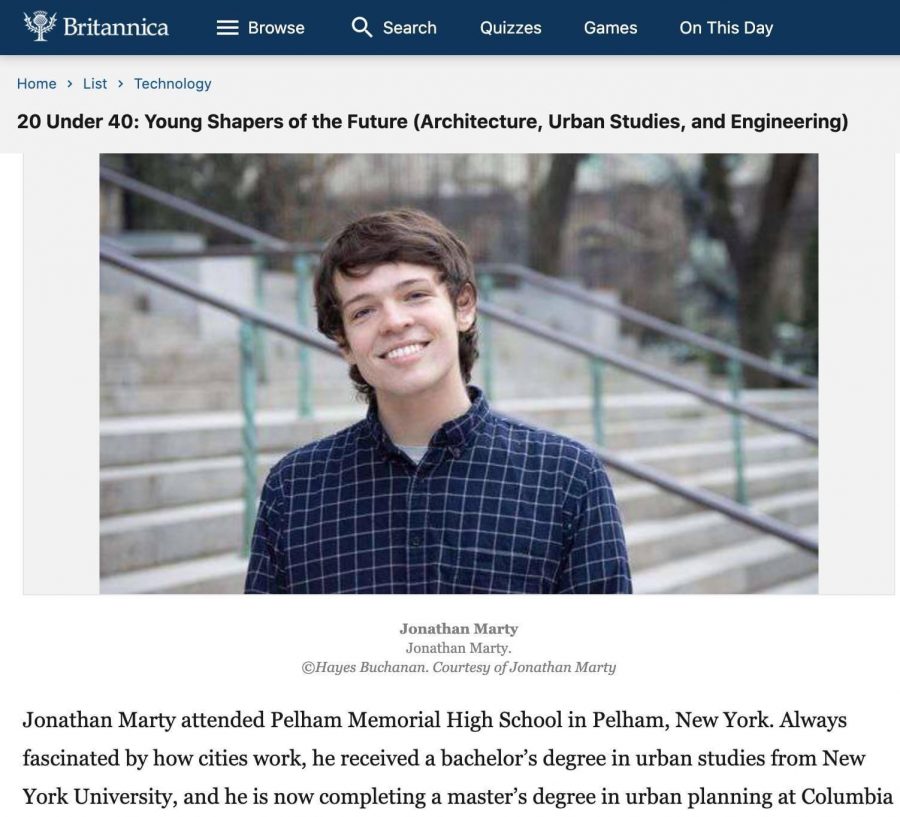Alum Jonathan Marty Named One of Encyclopædia Britannica’s “Young Shapers of the Future”
February 19, 2021
Pelham Memorial High School alumnus Jonathan Marty has been named one of Encyclopædia Britannica’s “Young Shapers of the Future.” In a Britannica article, 20 individuals under 40 years old involved in the fields of architecture, urban studies, and engineering were accredited for their contributions to guiding “future thought.” At age 24, Marty was the youngest individual on the list.
Marty co-founded a Facebook group in March of 2017 named “New Urbanist Memes for Transit-Oriented Teens” or “Numtots” for short. By the end of 2020, the Facebook group had amassed over 211,000 members. According to an article written by CityLab, “NUMTOT is a place to get engaged with matters of profound importance to local communities”. In addition to memes and discussion, members of Numtots have taken classes on urban planning and applied for jobs and internships working in city hall and the Department of Transportation.
“It’s a fun and casual place to discuss urbanism, transit, and architecture with people from all around the world,” Marty said.
Marty received his bachelor’s degree in urban studies from New York University, and is currently completing a master’s degree in urban planning at Columbia University.
He recently sat down with The Pel Mel to discuss his experiences:
Is there any advice/message you can give to current PMHS students?
Jonathan Marty: While Pelham is nice and all, never forget that you live right on top of what is literally the greatest city on earth. Try to spend as much time in New York as you can — go on a bike ride in the Bronx, take the train into Grand Central, go on a day trip with your friends to Brooklyn or Queens. It will expand your mind in wonderful ways, introducing you to new cultures, art, cuisine, languages, and lifestyles. We are very fortunate to live in a town that’s so close to such an amazing place.
Is there any advice you can give to someone who is interested in urban planning?
Jonathan Marty: First, I would recommend reading The Power Broker by Robert Caro. It’s a fantastic, classic book about Robert Moses — the man who built much of the infrastructure in the New York metro area in the 20th century (including Hutch which runs right by PMHS!) I would also implore you to go on walks and look critically at the built environment. Ask questions like, why do different neighborhoods look the way they do? Which systems, such as public transit, govern the way you live? What makes a good street feel safe, vibrant, and interesting? What makes a bad street feel unsafe, boring, or dull? Finally, you should join the Facebook group “New Urbanist Memes for Transit-Oriented Teens” that my friends and I run. It’s a fun and casual place to discuss urbanism, transit, and architecture with people from all around the world.
What inspired you to go into urban planning?
Jonathan Marty: I remember going to a Yankees game as a child and being amazed at the sight of the elevated 4 train running above River Avenue in the Bronx. Ever since, I’ve been transfixed by New York, but also by cities of all shapes and sizes. While you might not always notice it, the decisions of urban planners literally define the way the world around you looks, how it is organized, and how it functions on a day-to-day basis. It is an immensely powerful tool that allows you to improve people’s lives, be it with a new park, new transit options, or new housing. Since the world is rapidly urbanizing, and since climate change is forcing cities all around the world to redesign themselves as more sustainable, resilient places, it seemed to me like the perfect profession to explore.
Is there any kind of specific skill set that is good for urban planning?
Jonathan Marty: First and foremost, you should have a working knowledge of modern urban history. Learn about things like redlining, urban renewal, public housing, and suburbanization. Since much of contemporary urban planning focuses on mitigating the effects of climate change, learn about sustainable energy sources, green technology, and resilient landscapes. It also certainly helps if you’re comfortable working with data, particularly statistics and ArcGIS mapping. In the early stages though, I would recommend learning how to appreciate “good” urban environments, and to figure out which of their qualities you appreciate. Finally, study up on contemporary problems in urban policy — public health, gentrification, racial segregation, car-dependency, pollution, homelessness, etc.




